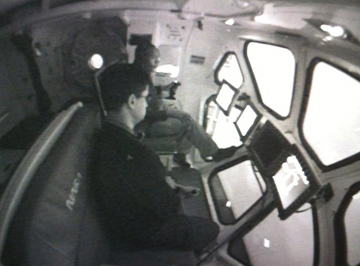 |
| Crewmates José Hurtado and Alvin Drew conduct an MMSEV flying simulation. |
Test-driving a spaceship. That is essentially the mission this week for me and my crewmate, astronaut Alvin Drew. As crew of the new prototype Mult-Mission Space Exploration Vehicle (MMSEV), we are test subjects in an important study of how well the MMSEV serves as a home and as a vehicle for exporing a near-Earth asteroid (NEA). To do that we are living and working in the MMSEV for three days during a simulated mission to a NEA.
During the day, we are kept busy with various tasks such as flying the vehicle, making simulated “spacewalks” or EVAs (extravehicluar activities), and other mission-oriented tasks. These are meant to test the various methods humans might use to explore a NEA. For example, today I did an EVA in the virtual reality lab. With a head-mounted display and special gloves, the lab allows me to experience the first-person view one would have in a spacesuit during a spacewalk. On this EVA, Alvin piloted the MMSEV in the simulation with me on the outside attached to a robotic arm. Our task was to visit a set of six points on the surface of the spinning asteroid using one of several possible stategies. These points could be sites for making scientific observations or for collecting samples. We chose to approach the targets at close range (a few meters) with me on the arm, at which point I would detach, acquire the target, and return to the MMSEV for a ride to the next point. Another EVA I did today was in the ARGOS facility where I practiced some of the types of tasks an astronaut might be doing at a study point on an asteroid. The ARGOS is a crane and winch system designed to suspend a human subject wearing a harness in such a precise manner as to offset their weight, simulating microgravity. In this simulation, I tried various concepts for collecting samples while floating about, including scooping loose material into a bag with a claw, picking up rock fragments with a gloved hand, and hammering pieces of rock off an outcrop. I also tested the use of tethers and lines vs. a rigid arm for anchoring and stability. These are just two of the various scenarios our three days of simulations is testing. The engineers, scientists, and mission planners at NASA are interested in which methods are the most efficient in terms of fuel and time (and hence consumables such as air) and which ones may be best for achieving science and mission objectives.
While we are conducting the mission and evaluating the performance of the vehicle for the exploration tasks, we are also paying close attention to the comfort and usability of the spacecraft as a mobile home. This includes the sleeping quarters, facilities for preparation of food, storage space, hygenie, and even the Waste Collection System (WCS) — our MMSEV toilet. Sleeping in the MMSEV is comfortable, and, with the whirring sounds of electronics and the air handling system, it sounds like the inside of an airliner. You have a little more room to spread out in here than you do on a plane, though! At night we can divide MMSSEV into two private sleep stations separated by the central aisle (and the WCS) and isloated from the cockpit and the suitports. The MMSEV can carry all the food we need on board, and it has a water dispenser/heater for drinking and rehydrating meals. Our mission this week is to live in here for three days (and so far I have few complaints!), but the vehicle is designed to support a two-person crew on missions of two weeks or longer. NASA will use the lessons we are learning this week to make those missions a reality.
